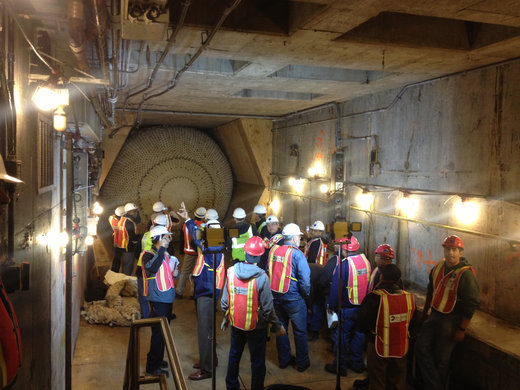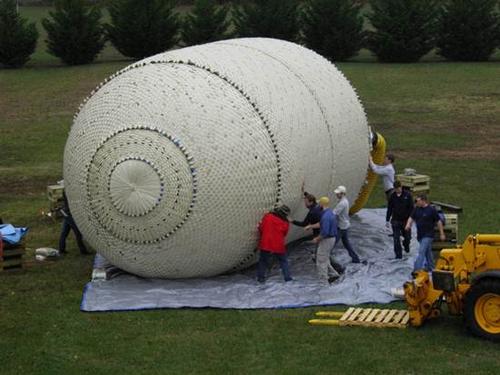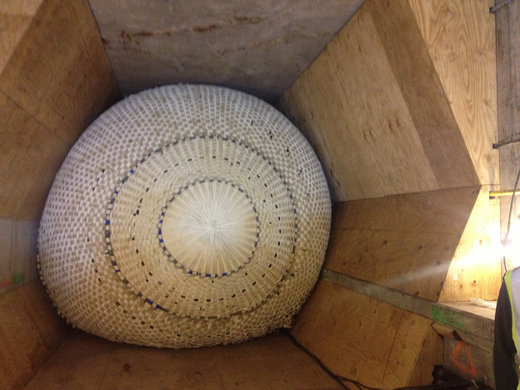19 November 2013
New York City has tested a giant, inflatable plug developed to block floodwaters and dangerous gases in mass transit tunnels, reports Rod Sweet.
For years experts have pondered how to block sections of tunnels quickly to check rampant flooding.
Such a system would have come in handy in New York when Superstorm Sandy caused a surge of seawater to rush through the subway network in October 2012. The damage was extensive and more than a year later parts of the network are still closed for reconstruction.
Installing retractable, watertight doors might work, but it would be incredibly expensive, and disruptive.
A better way would be to plug the tunnels somehow, the way you plug a drain with a rubber stopper. But how?
As it happens, nine months before Sandy the US Department of Homeland Security had successfully tested such a system – an enormous, cylindrical bladder that can be filled with water or air in minutes to seal a tunnel.

A tunnel plug under development by ILC Dover is tested in New York, October 2013 (MTAphotos)
Led by the department’s Science and Technology Directorate (STD) the tunnel plug project got underway in 2007, and the design went through various iterations before arriving at what it is now: a bag 32 feet long and 16 feet wide that can hold 35,000 gallons, about the same capacity as a backyard swimming pool.
When not in use, the plug packs into a small storage space in the tunnel ready for emergency, remote-controlled inflation.
Designing, building, and testing the giant capsule proved quite complicated. “No one’s ever done this before,” said STD project manager Dr. John Fortune. “It’s a completely novel technology.”
One problem was that rail tunnels are anything but smooth. Pipes, vents, lights, subway tracks and service walkways create a jagged profile that is difficult to seal.
The team also needed to make the plug strong enough when inflated to restrain a full tunnel’s worth of water, yet pliable enough to be compressed into a small space when not in use.

The prototype developed in collaboration with ILC Dover is 32 feet long and 16 feet wide. (ILC Dover)
Working with Pacific Northwest National Laboratory, West Virginia University (WVU) and engineering firm ILC Dover, a longtime maker of NASA space suits, the STD team designed the plug’s full circumference to be larger than the tunnel itself, so it would fill all the spaces.
The team tested different fabrics and shapes. A single-layer inflatable plug seemed promising but the design failed under full-scale pressure testing.
They ultimately settled on a design with three separate layers. On the outside is thick webbing made of a liquid-crystal polymer fiber called Vectran. Two additional layers, one of non-webbed Vectran and one of polyurethane, seal the air or water inside.
Because textile engineering is expensive the team used fabrics already available, but the design and manufacturing techniques were the same as those used for space suits and ‘inflatable space habitats’, according to ILC Dover.
In January 2012 the team tested the plug in a specially-built tunnel in Morgantown, West Virginia.

(MTAphotos)
First they inflated the plug with air until it filled the shape of the tunnel, then they replaced the air with water to achieve the required pressure. Sealing one end of the tunnel, they flooded it with enough water to mimic the pressure of a real tunnel-flood below sea-level – and the plug held.
Last month New York’s Metropolitan Transportation Authority (MTA) tested the tunnel plug at the new South Ferry subway station, which has been closed since Superstorm Sandy filled the entire station with over 14 million gallons of corrosive salt water.
New York state governor Andrew Cuomo witnessed the demonstration, and was impressed.
“One year after Sandy, I am pleased to see MTA’s progress in making its network stronger and more resilient, so we can keep New Yorkers moving in the future,” he said.
The system provides “an affordable, easily installed, quickly deployable solution to protect vital mass transit systems”, the Department of Homeland Security claims.
New Yorkers will be hoping it can be deployed before another superstorm strikes.






